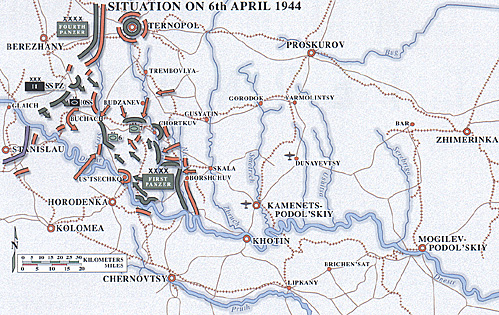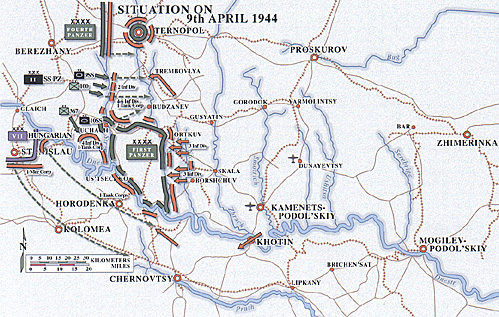 Up until this time, the Soviets were unsure
of the direction in which the Germans would
flee. German interceptions of Soviet radio
transmissions seemed to indicate that the
Soviets were convinced it would be to the
south. However, on March 31st, the Soviet
high command drew the correct conclusions and
decided that the Germans were breaking out
due west.
Up until this time, the Soviets were unsure
of the direction in which the Germans would
flee. German interceptions of Soviet radio
transmissions seemed to indicate that the
Soviets were convinced it would be to the
south. However, on March 31st, the Soviet
high command drew the correct conclusions and
decided that the Germans were breaking out
due west.
To reflect this, Zhukov recalled the Fourth Tank Army that was south of the Dnestr River and directed it to attack toward Gorodenka. This attack failed because of supply problems.
Meanwhile, the Germans continued westward reaching the Nielava. River. The 7th Panzer Division even secured a bridgehead west of Borschuy until the Soviet advance toward Gorodenka pushed it back. Through intercepted messages, the Germans had spotted the Soviet forces at Yarmolintsy through Gusyatin, and knew that 3-4 divisions had crossed the Zbruch River and 80 tanks were around the Chortkov area.
Taking advantage of this information, the 17th Panzer and part of Group "Golinicle' collared the two bridges over the Zbruch River to the north and some 15 kilometers northwest of the Dnestr's mouth.
April 1st brought another 75 tons of supplies in on 57 Ju 52 transports, while Soviet forces had reached the Stanislau area. By this time, Hitler had scraped up a relief force comprised of the II SS Panzer Corps (9th and 10th SS Panzer Divisions) and a few infantry divisions. These units were employed in part to stiffen resistance in the Brody/Ternopol area and in part to drive towards the First Panzer Army.
The relief force units began arriving with the 100th Jaeger Division detraining near Berezhany. Its mission was to secure that town while the 365th Infantry Division secured Rogatin.
Once the 100th Jaeger did this, it was to proceed down the main road to Buchach clearing the way of Soviet units for the SS panzers to follow. Once contact with First Panzer Army had been made and the road secured some 600 tons of supplies for First Panzer Army would be delivered. However, the road was covered with huge snowdrifts of 200- 500 yards wide. Therefore, for the next few hours the infantry division shoveled its way through.
Once completed, the Tigers of the 10th SS Panzer moved through, knocking out some 36 T-34 tanks prior to reaching the Strypa River. Once there, the 10th SS ran directly into a Soviet wall of fire composed of entrenched anti-tank guns. It wasn't until the Luftwaffe arrived that the resistance was overcome. By now, the advance was well off schedule.
To overcome this, the commander of the 10th SS Panzer Division ordered the units off the road to take a cross-country shortcut. Normally this might have worked, but the recent weather had been a mix of snow and rain, and the precipitation turned the roads into mud. The division became engulfed in a sea of brown, sticky glue. In fact, the only units that did find their way out were the divisional commander and five tanks!
Meanwhile, on April 2nd, the 7th and 17th Panzer Divisions reached the Seret River at Chortkuv followed by the 1st Panzer Division a day later. Hitler dismissed Manstein and Kluge as the commanders of Army Groups South and "A". In keeping with the flight from reality of the times, Army Groups South and "A" were renamed Army Groups North Ukraine and South Ukraine and Field Marshal Model and Schroner respectively were appointed to the posts.
While the first two days of April proved to be a blizzard, the third day was rain and mud. The Soviets attacked southward from Chortkuy, east of the Seret River, with 5-7 infantry divisions and the Third Guards Tank Army. Another Soviet corps had already crossed west of the Seret.
On April 4th, the 1st and 7th Panzer Divisions fought their way into the town of Chortkuv while the 6th Panzer and 509th Heavy Tank Battalion was still six miles east of the Strypa. The 17th Panzer Division remained near Usteshko and Hube was finally informed that the 10th SS Parizer Division would attack toward Buchach the next day to link up with First Panzer Army.
 April 5th arrived and with it the Soviet
2nd Guards Tank Corps attacked Ustenko but
was repelled by the 17th Panzer Division. The
6th Panzer Division and 509th Heavy Tank
Battalion reached the Strypa River and began an
attack toward Buchach entering it by the 8th.
By this time the 509th had only 2 Tiger tanks
left. It was on this day that the commander of
the 10th SS Panzer Division with his five tanks
met with a few 6th Panzer Division units but
the link-up was not secure.
April 5th arrived and with it the Soviet
2nd Guards Tank Corps attacked Ustenko but
was repelled by the 17th Panzer Division. The
6th Panzer Division and 509th Heavy Tank
Battalion reached the Strypa River and began an
attack toward Buchach entering it by the 8th.
By this time the 509th had only 2 Tiger tanks
left. It was on this day that the commander of
the 10th SS Panzer Division with his five tanks
met with a few 6th Panzer Division units but
the link-up was not secure.
Model and Hube met at Buchach and discussed the situation. Despite the desperate straits of First Panzer Army, Germany itself had long been stripped bare of fresh troops and equipment. Instead of a much needed rest, First Panzer Army would immediately have to form a defensive line along the Seret River to hold the Soviets, even as it tried to extricate its rearguard units from the pocket!
It wasn't until April 9th that all of First Panzer Army, including its rearguard units, was west of the Seret River. Of course some six Soviet divisions were west of the river as well. The II SS Panzer Corps with its 200+ tanks provided a last mopping up and had little problem in pushing back Soviet forces as it crossed the Strypa River. First Panzer Army was finally secure.
The II SS Panzer Corps was redeployed slightly northwards to spearhead an attack to relieve Ternopol in mid-April that proved an utter fiasco. Still, the scope and success of the Soviet operations kept Hitler's eyes focused firmly on this theater. He was convinced future Soviet efforts would take place against the First and Fourth Panzer Armies and so built up men and supplies behind the front. The Germans found their mobile forces badly misdeployed to meet the gigantic Summer Offensive unleashed by STAVKA in June against Army Group Center to the north.
These forces in the East were intended to hold the Russian advance roughly on the old Russian frontier -- the frontier of 1938. In April, Hitler still believed that this might be done.
- Telegram.
High Command of the Army.
2nd April 1944.
Operational Order No. 7 Directive for further operations by Army Group A, Army Group South, and Army Group Center
1. The Russian offensive in the South of the Eastern front has passed its climax. The Russians have exhausted and divided their forces.
The time has now come to bring the Russian advance to a final standstill.
For this reason I have introduced measures of a most varied kind. It is now imperative, while holding firm to the Crimea, to hold or win back the following line: Dniester to north-east of Kishinev- Jassy-Targul Neamt and the Eastern exit from the Carpathians between Targul Neamt and Kolomyya-Ternopol-Brody-Kovel.
2. For the present, Army Group A will hold the line Tiligulski-Liman- Dniester around Dubosari, until we can assume that the Crimea can be supplied independently of Odessa. No more will be done than to prepare for the retreat to the Dniester line. After closing the gap between 8th Army and the Carpathians, the strongest possible forces will be switched quickly from the right flank to the left flank of the Army Group. Rumanian forces must be made mobile and deployed forward by us in every way possible.
Rumanian forces will be disposed in accordance with the terrain, so that chiefly German troops occupy the sectors in danger of enemy tank attack.
It is particularly important that the heavy anti-tank guns which I have placed at the disposal of the Rumanians should reach them as early as possible, and be brought into position in the most threatened areas. They will be manned by German gun-crews. This may be a question of hours. The Army Group is fully responsible for this, and will employ a special staff to deal with it.
3. The chief task of Army Group South is to free the surrounded 1st Panzer Army. 1st Panzer Army must continue to break through to the north-west.
An offensive force of great striking power will be formed in the area southeast of Lemberg from available and newly arriving formations. This force must advance southwest at the earliest possible moment, in strong concentration, in order to annihilate the enemy forces which have broken through in the Stanislav area, and to reestablish connection with 1st Panzer Army. In general, I am in agreement with the plans of Field Marshal von Manstein.
After contact has been established with 1st Panzer Army, the line originally laid down will finally be secured by local attacks; contact will be made with Army Group Center, south of Kovel; and a unified front will be established. The Hungarian forces which have been raised in Hungary will come under command of Army Group South. It is important here, too, to put them in the front line along with German formations to stiffen them.
Rigorous orders are necessary here.
4. For Army Group Center, I am in full agreement with the heavy concentration around Brest-Litovsk [in southern Poland].
The first task of Army Group Center is to fight its way out of Kovel and establish contact with Army Group South.
- signed: ADOLF HITLER
Kesselschlacht March-April 1944
- Introduction and Background
Terrain and Weather
The Deception
The Battle Begins
Breakout
Aftermath
The Face of Battle
All Daily Situation Maps (monstrously slow: 1.646Mb!)
Back to Table of Contents -- Against the Odds vol. 1 no. 3
Back to Against the Odds List of Issues
Back to MagWeb Magazine List
© Copyright 2002 by LPS.
This article appears in MagWeb.com (Magazine Web) on the Internet World Wide Web.
Other articles from military history and related magazines are available at http://www.magweb.com
* Buy this back issue or subscribe to Against the Odds direct from LPS.
